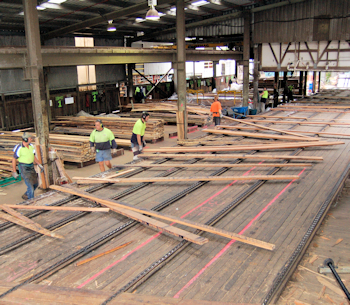Physical and mechanical properties

testing the bending strength of a piece of structural radiata pine
Wood properties are often divided into two categories – physical properties and mechanical properties. In practice, some properties would easily fit into either group, or have overlapping characteristics with other properties from both groups. For the purposes of this lesson, we will use these two category headings to break up the various characteristics being discussed, but keep in mind that there are no hard and fast boundaries for these categories.
Note that there are various technical terms used in the descriptions below. These are all explained in other lessons covering specific topics in more detail.
Physical properties
Physical properties encompass the characteristics that are inherent in a piece of wood. They include:
Physical properties encompass the characteristics that are inherent in a piece of wood. They include:
Moisture content – a measure of how much water is in the cell walls and cavities of the wood, which may vary greatly between species when the wood is green and affect several other properties as the fibres progressively dry down to EMC (equilibrium moisture content).
Dimensional stability – referring to the movement that takes place as the wood dries, including shrinkage (in width, thickness and length) and distortion (such as bow, spring twist and cup).
Density – a measure of the wood’s mass for a given volume; providing an indication of how densely the woody material is packed together.

where boards are selected for milling into flooring profiles
Durability – the ability of the wood to resist attack from fungal decay and insects, either due to the wood’s natural chemical deterrents or through the use of preservative treatments that are applied during the processing stage.
Colour – which is mostly determined by the extractives contained in the cell cavities and the natural variations that occur during the tree’s growth.
Figure and grain – describing the appearance and patterns formed by the growth rings and wood fibres on the surface of the timber when it is cut in certain ways.
Mechanical properties
Mechanical properties relate to the wood’s performance when an external force is applied to it. They include:
Strength – which can be measured in various ways, depending on whether the stress force being applied has a tendency to bend, compress, stretch or shear the wood fibres.
Hardness – the ability of the wood to resist indentation, wear and abrasion, which are important characteristics for timber used in high traffic areas or for heavy duty applications.
Toughness – also called impact strength, which is a measure of the wood’s ability to withstand shocks and blows without fracturing.
See the following lessons for more details on these properties.